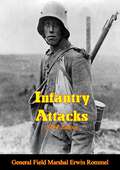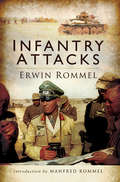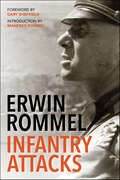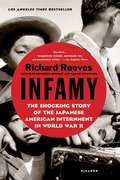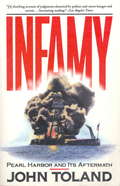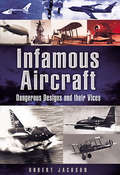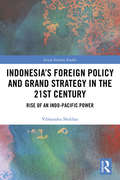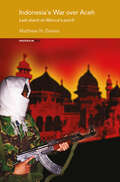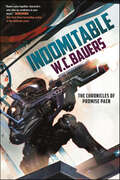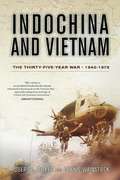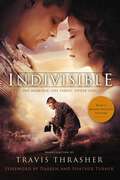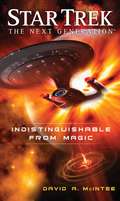- Table View
- List View
Infantry Attacks [1944 Edition]
by General Field Marshal Erwin RommelInfantry Attacks is a classic text in the field of military strategy. Written by German Field Marshal Erwin Rommel, it was first published in 1937 as a journal-esque chronicle of the author's experiences in World War I and the lessons he learned there. In it, he provides detailed accounts of a variety of military strategies that rely on speed, deception, and deep penetration into enemy territory to intimidate and surprise opposing forces. Considered by his troops and enemies alike to be a humane, professional and immensely skilled officer, Rommel's use of intimidation and the advantage of surprise often forced enemies to surrender quickly, thereby avoiding unnecessary risk of injury and death for his troops (and their enemies), exertion, and expenditure of ammunition.Infantry Attacks was widely read by soldiers and military leaders upon its release and has become something of a staple in military education, providing a detailed glimpse into the tactics of an extremely effective and widely respected officer. It has been studied extensively throughout the West, particularly in the United States. The revered General George S. Patton is said to have been heavily influenced by this text.Rommel was appointed to the rank of high commander by Adolf Hitler in part because of the success of this book. Such positions were ordinarily reserved for members of old military families and the Prussian aristocracy, so this assignment spoke to Rommel's competence and the influence of his writing. Rommel went on to lead Hitler's Afrika Korps in North Africa. Although he planned to release a sequel based on his experiences there, he was unable to complete the manuscript before his death in 1944.-Print ed.
Infantry Attacks (Zenith Military Classics Ser.)
by Erwin RommelField Marshal Erwin Rommel exerted an almost hypnotic influence not only over his own troops but also over the Allied soldiers of the Eighth Army in the Second World War. Even when the legend surrounding his invincibility was overturned at El Alamein, the aura surrounding Rommel himself remained unsullied. In this classic study of the art of war Rommel analyses the tactics that lay behind his success. First published in 1937 it quickly became a highly regarded military textbook, and also brought its author to the attention of Adolph Hitler. Rommel was to subsequently advance through the ranks to the high command in the Second World War. As a leader of a small unit in the First World War, he proved himself an aggressive and versatile commander, with a reputation for using the battleground terrain to his own advantage, for gathering intelligence, and for seeking out and exploiting enemy weaknesses. Rommel graphically describes his own achievements, and those of his units, in the swift-moving battles on the Western Front, in the ensuing trench warfare, in the 1917 campaign in Romania, and in the pursuit across the Tagliamento and Piave rivers.This classic account seeks out the basis of his astonishing leadership skills, providing an indispensable guide to the art of war written by one of its greatest exponents.
Infantry Attacks
by Erwin RommelLegendary German general Erwin Rommel analyzes the tactics that led to his success. Field Marshal Erwin Rommel exerted an almost hypnotic influence not only over his own troops but also over the Allied soldiers of the Eighth Army in the Second World War. Even when the legend surrounding his invincibility was overturned at El Alamein, the aura surrounding Rommel himself remained unsullied. In this classic study of the art of war Rommel analyses the tactics that lay behind his success. First published in 1937 it quickly became a highly regarded military textbook, and also brought its author to the attention of Adolph Hitler. Rommel was to subsequently advance through the ranks to the high command in the Second World War. As a leader of a small unit in the First World War, he proved himself an aggressive and versatile commander with a reputation for using the battleground terrain to his own advantage, for gathering intelligence, and for seeking out and exploiting enemy weaknesses. Rommel graphically describes his own achievements, and those of his units, in the swift-moving battles on the Western Front, in the ensuing trench warfare, in the 1917 campaign in Romania, and in the pursuit across the Tagliamento and Piave rivers. This classic account seeks out the basis of his astonishing leadership skills, providing an indispensable guide to the art of war.
Infamy: The Shocking Story of the Japanese-American Internment in World War II
by Richard ReevesLess than three months after Japan bombed Pearl Harbor and inflamed the nation, President Roosevelt signed an executive order declaring parts of four western states to be a war zone operating under military rule. The U.S. Army immediately began rounding up thousands of Japanese-Americans, sometimes giving them less than 24 hours to vacate their houses and farms. For the rest of the war, these victims of war hysteria were imprisoned in primitive camps. In Infamy, the story of this appalling chapter in American history is told more powerfully than ever before. Acclaimed historian Richard Reeves has interviewed survivors, read numerous private letters and memoirs, and combed through archives to deliver a sweeping narrative of this atrocity. Men we usually consider heroes-FDR, Earl Warren, Edward R. Murrow-were in this case villains, but we also learn of many Americans who took great risks to defend the rights of the internees. Most especially, we hear the poignant stories of those who spent years in "war relocation camps," many of whom suffered this terrible injustice with remarkable grace. Racism, greed, xenophobia, and a thirst for revenge: a dark strand in the American character underlies this story of one of the most shameful episodes in our history. But by recovering the past, Infamy has given voice to those who ultimately helped the nation better understand the true meaning of patriotism.
Infamy
by John TolandBestselling author and historian John Toland's expertise and skill as a narrator were awarded with the Pulitzer Prize for his sweeping Rising Sun. In Infamy, Toland extends and corrects his account of the events leading up to Japan's attack on Pearl Harbor, addressing persistent questions: Could FDR have engineered a conspiracy to get the US into the War? Did high-level military and civilian leaders lie under oath? Were the wrong men held culpable in order to protect Washington? Accessing formerly secret government, military, and diplomatic records--including the account of the then anonymous and controversial "Seaman Z"--Toland masterfully reevaluates what we know about this infamous act of aggression against the US.
Infamous Aircraft: Dangerous designs and their vices
by Robert JacksonMany aircraft, some famous and some rare, gained a reputation for being difficult to fly and sometimes downright dangerous. This book looks at some of the worst culprits over a period spanning World War One to the age of supersonic flight. The following aircraft are included.BE.2—The RFC went to war in it in 1914. The BE was easy to fly and very stable—but it was difficult to maneuver and very easy to shoot down. Tarrant Tabor—The Tabor was grotesque, a massive misfit of an experimental bomber that predictably came to grief on its first flight. Avro Manchester—The twin-engined Manchester would fly all the way to Berlin and back—only to burst into flames over its own base. Messerschmitt Me 210—The Me 210 was developed as a successor to Goering's Destroyer, the Bf110. It was a disaster with a phenomenal accident rate. Martin B-26 Marauder—They called the B-26 the Widow-maker, fast and powerful, with some savage characteristics. Reichenberg IV—a manned version of the V-1 flying bomb, was a desperation weapon, its pilots intended to fly suicide missions against Allied shipping. Tu-144—Rushed prematurely into its test program to beat the Anglo-French Concorde, the TU-144 was intended to be Russia's supersonic dream.
Inequality, Grievances, and Civil War
by Lars-Erik Cederman Kristian Skrede Gleditsch Halvard Buhaug Lars-Erik Cederman Kristian Skrede GleditschThis book argues that political and economic inequalities following group lines generate grievances that in turn can motivate civil war. Larks-Erik Cederman, Kristian Skrede Gleditsch, and Halvard Buhaug offer a theoretical approach that highlights ethnonationalism and how the relationship between group identities and inequalities are fundamental for successful mobilization to resort to violence. Although previous research highlighted grievances as a key motivation for political violence, contemporary research on civil war has largely dismissed grievances as irrelevant, emphasizing instead the role of opportunities. This book shows that the alleged non-results for grievances in previous research stemmed primarily from atheoretical measures, typically based on individual data. The authors develop new indicators of political and economic exclusion at the group level, and show that these exert strong effects on the risk of civil war. They provide new analyses of the effects of transnational ethnic links and the duration of civil wars, and extended case discussions illustrating causal mechanisms.
Industry and Air Power: The Expansion of British Aircraft Production, 1935-1941 (Studies in Air Power #Vol. 5)
by Sebastian Ritchie Noel Sebastian RitchieThe author begins with a general survey of British aircraft manufacturing in the inter-war period. Policy, production, finance and contracts are examined, and the final chapter is concerned with the mobilization of the aircraft industry in 1939, and the emergency measures of 1940.
Industrial Mobilization: The Relevant History
by Roderick L. VawterIndustrialization mobilization planning is an old idea in the history of modern warfare. In the United States, in fact, the National Defense Act of 1920 required the Federal Government to conduct such planning. Current reforms were inspired when, in 1978, a series of mobilization exercises revealed serious and dangerous deficiencies in mobilization planning. The basic premise of this historical study is that industrial mobilization lessons of the past provide answers for many of today’s problems. The author contends that current industrial mobilization planners should draw lessons more from the Korean War effort than from World War II. The Korean mobilization effort supported not only the demands of that war, but also the readiness needs to counter an anticipated Soviet attack. After describing the Korean experience in detail, the author examines changes in industrial mobilization planning that evolved as the nation perceived an easing of the Soviet threat. He highlights problems that, should they remain unsolved, ultimately would preclude effective industrial mobilization planning. Finally, he recommends realistic actions to restore effective planning.
Industrial Espionage: Developing a Counterespionage Program
by Daniel J. BennyThe FBI estimates that billions of U.S. dollars are lost each year to foreign and domestic competitors who deliberately target industrial trade secrets. And, although today‘s organizations face unprecedented threats to the security of their proprietary information and assets, most books on industrial espionage fail to supply guidelines for establis
Industrial Collaboration in Nazi-Occupied Europe
by Hans Otto Frøland Mats Ingulstad Jonas SchernerThis book bringstogether leading experts to assess how and whether the Nazis were successful infostering collaboration to secure the resources they required during World WarII. These studies of the occupation regimes in Norway and Western Europe revealthat the Nazis developed highly sophisticated instruments of exploitationbeyond oppression and looting. The authors highlight that in comparison to theheavy manufacturing industries of Western Europe, Norway could provide many rawmaterials that the German war machine desperately needed, such as aluminium,nickel, molybdenum and fish. These chapters demonstrate that the Nazis providedincentives to foster economic collaboration, hoping that these would make everymine, factory and smelter produce at its highest level of capacity. All readerswill learn about the unique part of Norwegian economic collaboration duringthis period and discover the rich context of economic collaboration acrossEurope during World War II.
Inducing Compliance with International Humanitarian Law
by Heike Krieger Krieger, Heike and Willms, Jan Jan WillmsThe number of armed conflicts featuring extreme violence against the civilian population in areas with no or little State authority has risen significantly since the early 1990s. This phenomenon has been particularly prevalent in the African Great Lakes Region. This collection of essays evaluates, from an interdisciplinary perspective, the various traditional and alternative instruments for inducing compliance with international humanitarian law. In particular, it explores the potential of persuasion, as well as hierarchical means such as criminal justice on the international and domestic level or quasi-judicial mechanisms by armed groups. Furthermore, it evaluates the role and potential of human rights bodies, peacekeeping missions and the UN Security Council's special compliance system for children and armed conflicts. It also considers how Common Article 1 to the Geneva Conventions and the law of State responsibility could both potentially increase compliance with international humanitarian law.
Indonesia’s Foreign Policy and Grand Strategy in the 21st Century: Rise of an Indo-Pacific Power (Asian Security Studies)
by Vibhanshu ShekharThis book examines the changes in Indonesian foreign policy during the 21st century as it seeks to position itself as a great power in the Indo-Pacific region. The rise of 21st-century Indonesia is becoming a permanent fixture in both the domestic and global discourses. Though there has been an increasing level of discussion on Indonesia’s emerging power status, there has been little discussion on how the country is debating and signalling its new-found status. This book combines the insights of both neo-classical realism and social identity theory to discuss a reset in an emerging Indonesia’s foreign policy during the 21st century while emphasizing domestic drivers and constraints of its international behaviour. There are three key organizing components of the book – emerging power, status signalling and the Indo-Pacific region. The Indo-Pacific region constitutes a spatial framing of the book; the emerging power provides an analytical category to explain Indonesia’s changing international status; and status signalling explains multiple facets of international behaviour through which the country is projecting its new status. Though leaders are adding different styles and characteristics to the rising Indonesia narrative, there are a few unmistakable overarching trends that highlight an increasing correlation between the country’s rising power and growing ambition in international behaviour. This book is built around four key signalling strategies of Indonesia as an emerging power – expanded regional canvas, power projection, leadership projection, and quest for great power parity. They represent Indonesia’s growing desire for a status-consistent behaviour, its response to the prevailing strategic uncertainty in the Indo-Pacific region and its attempt to advance its strategic interests. This book will be of much interest to students of South-East Asian politics, strategic studies, international diplomacy, security studies and IR in general.
Indonesia's War over Aceh: Last Stand on Mecca's Porch (Politics in Asia)
by Matt DaviesSince 2001, Indonesia’s military commitment to Aceh province resulted in one of Southeast Asia’s largest wars for decades. Indonesia's War over Aceh presents the background and history of this war, investigating its domestic and international implications, at a time when the recent tsunami catastrophe has brought Aceh to world attention. Using military doctrinal references and extensive, original research, Davies reconstructs reported events, combatant forces, terminology and statistical data to expose many of the war’s sensitive issues. He challenges others’ preceding research by detailing the Indonesian military’s mission, structures, combat strains, and activity within political, operational and paramilitary realms. Drawing on Indonesian-Malay sources normally unseen by the English-speaking world, Indonesia's War over Aceh will be essential reading for regional specialists and those interested in contemporary conflict.
Indomitable: The Chronicles Of Promise Paen, Book 2 (The Chronicles of Promise Paen #2)
by W. C. BauersIndomitable: the second in W. C. Bauers's Chronciles of Promise Paen, character-driven military science fiction featuring a female space marine.Promise Paen, captain of Victor Company's mechanized armored infantry, is back for another adventure protecting the Republic of Aligned Worlds. Lieutenant Paen barely survived her last encounter with the Lusitanian Empire. She's returned home to heal. But the nightmares won't stop. And she's got a newly reconstituted unit of green marines to whip into shape before they deploy. If the enemies of the RAW don't kill them first, she just might do the job herself.Light-years away, on the edge of the Verge, a massive vein of rare ore is discovered on the mining planet of Sheol, which ignites an arms race and a proxy war between the Republic and the Lusitanians. Paen and Victor Company are ordered to Sheol, to reinforce the planet and hold it at all costs. On the eve of their deployment, a friendly fire incident occurs, putting Paen's career in jeopardy and stripping her of her command. When the Lusitanians send mercenaries to raid Sheol and destabilize its mining operations, matters reach crisis levels. Disgraced and angry, Promise is offered one shot to get back into her mechsuit. But she'll have to jump across the galaxy and possibly storm the gates of hell itself. At the Publisher's request, this title is being sold without Digital Rights Management Software (DRM) applied.
Indochina and Vietnam
by Robert Miller Dennis D. WainstockThe Indochina and Vietnam Wars followed one another over thirty-five years, from 1940 to 1975, yet these two closely related conflicts are usually treated separately. This book seeks to tell the story of those wars as a single historical event. Within days of France's defeat by Nazi Germany and Japan's military expansion into Southeast Asia in July 1940, the United States became involved in Indochina. Most histories quickly mention the colonial past, usually limited to the battle of Dien Bien Phu, to concentrate exclusively on the American war. A selection of published sources explains the context and the development of the long war while providing an overview of France's imprint on Indochina and Vietnam.The question "Why were we in Vietnam?" comes up regularly regarding the root causes for the ultimate deployment of over five hundred thousand US troops, most of them conscripts, into a virtually unknown land. When France left Indochina in 1954 it became an American problem. Weeks before the murder of John F. Kennedy came the overthrow of Ngo Dinh Diem and the escalation of the war in 1965-68. Finally, Richard Nixon, after extending the war into Cambodia, enacted both the Vietnamization process and negotiations in Paris between Henry Kissinger and Le Duc Tho, until the final act in April 1975, when the US embassy rooftop with the last helicopter taking off was flashed around the world as the grand finale to the war.
Indochina and Vietnam
by Robert Miller Dennis D. WainstockThe Indochina and Vietnam Wars followed one another over thirty-five years, from 1940 to 1975, yet these two closely related conflicts are usually treated separately. This book seeks to tell the story of those wars as a single historical event. Within days of France's defeat by Nazi Germany and Japan's military expansion into Southeast Asia in July 1940, the United States became involved in Indochina. Most histories quickly mention the colonial past, usually limited to the battle of Dien Bien Phu, to concentrate exclusively on the American war. A selection of published sources explains the context and the development of the long war while providing an overview of France's imprint on Indochina and Vietnam.The question "Why were we in Vietnam?" comes up regularly regarding the root causes for the ultimate deployment of over five hundred thousand US troops, most of them conscripts, into a virtually unknown land. When France left Indochina in 1954 it became an American problem. Weeks before the murder of John F. Kennedy came the overthrow of Ngo Dinh Diem and the escalation of the war in 1965-68. Finally, Richard Nixon, after extending the war into Cambodia, enacted both the Vietnamization process and negotiations in Paris between Henry Kissinger and Le Duc Tho, until the final act in April 1975, when the US embassy rooftop with the last helicopter taking off was flashed around the world as the grand finale to the war.
Indivisible: A Novelization
by Travis Thrasher Darren Heather TurnerDarren and Heather Turner share a passion for serving God, family, and country. When Darren is deployed to Iraq as an army chaplain, Heather vows to serve military families back home as she cares for the couple’s three young children. <p><p> Darren knows he’s overseas to support the troops in their suffering as their chaplain. What he doesn’t know is how he will get through his own dark moments. And as communication from Darren dwindles, Heather wonders what is happening in her husband’s heart. Meanwhile, she’s growing weary in the day-to-day life of a military base—each child’s milestone Darren will never see, each month waiting for orders, each late-night knock on the door. <p> When Darren returns, he is no longer the husband Heather once knew. She is no longer the woman Darren wed. And so it’s at home that the Turners face their biggest battle: to save their marriage. Based on the screen play by David Evans, Indivisible is a tribute to the beauty of serving our country, the courage of choosing love in the darkness, and the power of a God who never gives up hope.
Individual Preparedness and Response to Chemical, Radiological, Nuclear, and Biological Terrorist Attacks
by Lynn E. Davis Tom LatourretteThe guide focuses on simple steps individuals can take to prepare for and respond to terrorist attacks with chemical, biological, radiological ("dirty bomb") and nuclear weapons. The guides contain both preparatory steps and specific response guidance. This includes what individuals will experience, what their goals should be, and what they should do during each type of attack
Indistinguishable from Magic: Indistinguishable from Magic (Star Trek: The Next Generation)
by David A. McInteeThe most talented Starfleet engineers of two generations unite to solve a two-hundred-year-old technological mystery that turns out to be only the beginning of a wider quest. With the support of Guinan and Nog, as well as the crew of the U.S.S. Challenger, Geordi La Forge and Montgomery Scott soon find themselves drawn into a larger, deadlier, and far more personal adventure. Helped by old friends and hindered by old enemies, their investigation will come to threaten everything they hold dear. Seeking out the new, and going where no one has gonebefore, Geordi, Scotty, and Guinan find that their pasts are very much of the present, and must determine whether any sufficiently advanced technology is really indistinguishable from magic.
Indimenticabile II Guerra Mondiale: Conseguenze della Straordinaria Seconda Guerra Mondiale
by Valeria Ciccotti Scott S. F. MeakerLa guerra ha sempre avuto la tradizione di cambiare la mappa sociale ed economica di una nazione. Il concetto di famiglia venne completamente distrutto con la diffusa devastazione della Seconda Guerra Mondiale. Questo libro segue l'esperienza di sei persone appartenenti a vari settori, coinvolte in questo conflitto globale, e nelle conseguenze della straordinaria Seconda Guerra Mondiale.
Indigenous Peoples of the British Dominions and the First World War
by Timothy C. WinegardThis pioneering comparative history of the participation of indigenous peoples of the British Empire in the First World War is based upon archival research in four continents. It provides the first comprehensive examination and comparison of how indigenous peoples of Canada, Australia, Newfoundland, New Zealand and South Africa experienced the Great War. The participation of indigenes was an extension of their ongoing effort to shape and alter their social and political realities, their resistance to cultural assimilation or segregation and their desire to attain equality through service and sacrifice. While the dominions discouraged indigenous participation at the outbreak of war, by late 1915 the imperial government demanded their inclusion to meet the pragmatic need for military manpower. Indigenous peoples responded with patriotism and enthusiasm both on the battlefield and the home front and shared equally in the horrors and burdens of the First World War.
Indigenous Peoples and the Second World War: The Politics, Experiences and Legacies of War in the US, Canada, Australia and New Zealand
by R. Scott Sheffield Noah RisemanDuring the Second World War, Indigenous people in the United States, Australia, New Zealand and Canada mobilised en masse to support the war effort, despite withstanding centuries of colonialism. Their roles ranged from ordinary soldiers fighting on distant shores, to soldiers capturing Japanese prisoners on their own territory, to women working in munitions plants on the home front. R. Scott Sheffield and Noah Riseman examine Indigenous experiences of the Second World War across these four settler societies. Informed by theories of settler colonialism, martial race theory and military sociology, they show how Indigenous people and their communities both shaped and were shaped by the Second World War. Particular attention is paid to the policies in place before, during and after the war, highlighting the ways that Indigenous people negotiated their own roles within the war effort at home and abroad.
Indigenous Continent: The Epic Contest for North America
by Pekka HämäläinenNATIONAL BESTSELLER New York Times Book Review • 100 Notable Books of 2022 Best Books of 2022 — New Yorker, Kirkus Reviews Longlisted for the Andrew Carnegie Medal for Excellence “I can only wish that, when I was that lonely college junior and was finishing Bury My Heart at Wounded Knee, I’d had Hämäläinen’s book at hand.” —David Treuer, The New Yorker “[T]he single best book I have ever read on Native American history.” —Thomas E. Ricks, New York Times Book Review A prize-winning scholar rewrites 400 years of American history from Indigenous perspectives, overturning the dominant origin story of the United States. There is an old, deeply rooted story about America that goes like this: Columbus “discovers” a strange continent and brings back tales of untold riches. The European empires rush over, eager to stake out as much of this astonishing “New World” as possible. Though Indigenous peoples fight back, they cannot stop the onslaught. White imperialists are destined to rule the continent, and history is an irreversible march toward Indigenous destruction. Yet as with other long-accepted origin stories, this one, too, turns out to be based in myth and distortion. In Indigenous Continent, acclaimed historian Pekka Hämäläinen presents a sweeping counternarrative that shatters the most basic assumptions about American history. Shifting our perspective away from Jamestown, Plymouth Rock, the Revolution, and other well-trodden episodes on the conventional timeline, he depicts a sovereign world of Native nations whose members, far from helpless victims of colonial violence, dominated the continent for centuries after the first European arrivals. From the Iroquois in the Northeast to the Comanches on the Plains, and from the Pueblos in the Southwest to the Cherokees in the Southeast, Native nations frequently decimated white newcomers in battle. Even as the white population exploded and colonists’ land greed grew more extravagant, Indigenous peoples flourished due to sophisticated diplomacy and leadership structures. By 1776, various colonial powers claimed nearly all of the continent, but Indigenous peoples still controlled it—as Hämäläinen points out, the maps in modern textbooks that paint much of North America in neat, color-coded blocks confuse outlandish imperial boasts for actual holdings. In fact, Native power peaked in the late nineteenth century, with the Lakota victory in 1876 at Little Big Horn, which was not an American blunder, but an all-too-expected outcome. Hämäläinen ultimately contends that the very notion of “colonial America” is misleading, and that we should speak instead of an “Indigenous America” that was only slowly and unevenly becoming colonial. The evidence of Indigenous defiance is apparent today in the hundreds of Native nations that still dot the United States and Canada. Necessary reading for anyone who cares about America’s past, present, and future, Indigenous Continent restores Native peoples to their rightful place at the very fulcrum of American history.
Indicted: A Thriller
by Tom SaricOne soldier thought he&’d outrun his past—until it came back to hunt him . . . A twisting international thriller by the author of Compromised. In the midst of Yugoslavia&’s bloody civil war, a young soldier witnesses something horrific. Something he was never meant to see . . . Sgt. Luka Pavic fled to the safety of Canada after entering a home to evacuate civilians before a bombing raid only to find fourteen corpses—and being falsely accused of the murders. Years later, he has succeeded in keeping his true identity a secret from everyone, even his wife and child. But when a mysterious man knocks on Luka&’s door, the world he left behind comes crashing down around him—and to save himself and his family, he must return to Croatia to unravel a conspiracy . . .
